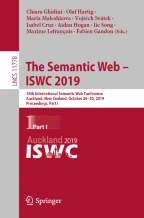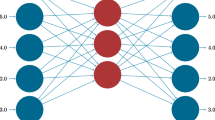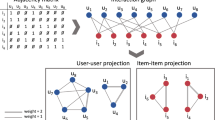How to Make Latent Factors Interpretable by Feeding Factorization Machines with Knowledge Graphs

Model-based approaches to recommendation can recommend items with a very high level of accuracy. Unfortunately, even when the model embeds content-based information, if we move to a latent space we miss references to the actual semantics of recommended items. Consequently, this makes non-trivial the interpretation of a recommendation process. In this paper, we show how to initialize latent factors in Factorization Machines by using semantic features coming from a knowledge graph in order to train an interpretable model. With our model, semantic features are injected into the learning process to retain the original informativeness of the items available in the dataset. The accuracy and effectiveness of the trained model have been tested using two well-known recommender systems datasets. By relying on the information encoded in the original knowledge graph, we have also evaluated the semantic accuracy and robustness for the knowledge-aware interpretability of the final model.
Authors are listed in alphabetical order.
This is a preview of subscription content, log in via an institution to check access.
Access this chapter
Subscribe and save
Springer+ Basic
€32.70 /Month
- Get 10 units per month
- Download Article/Chapter or eBook
- 1 Unit = 1 Article or 1 Chapter
- Cancel anytime
Buy Now
Price includes VAT (France)
eBook EUR 42.79 Price includes VAT (France)
Softcover Book EUR 52.74 Price includes VAT (France)
Tax calculation will be finalised at checkout
Purchases are for personal use only
Similar content being viewed by others

A qualitative analysis of knowledge graphs in recommendation scenarios through semantics-aware autoencoders
Article Open access 19 January 2024

An Interpretable Recommendations Approach Based on User Preferences and Knowledge Graph
Chapter © 2019

A graph-based approach for minimising the knowledge requirement of explainable recommender systems
Article Open access 25 May 2023
Notes
References
- Abdollahi, B., Nasraoui, O.: Explainable matrix factorization for collaborative filtering. In: Proceedings of the 25th International Conference on World Wide Web, WWW 2016, Montreal, Canada, 11–15 April 2016, Companion Volume, pp. 5–6 (2016) Google Scholar
- Abdollahi, B., Nasraoui, O.: Explainable restricted Boltzmann machines for collaborative filtering. CoRR abs/1606.07129 (2016) Google Scholar
- Adomavicius, G., Kwon, Y.O.: Multi-criteria recommender systems. In: Ricci, F., Rokach, L., Shapira, B. (eds.) Recommender Systems Handbook, pp. 847–880. Springer, Boston, MA (2015). https://doi.org/10.1007/978-1-4899-7637-6_25ChapterGoogle Scholar
- Adomavicius, G., Tuzhilin, A.: Context-aware recommender systems. In: Ricci, F., Rokach, L., Shapira, B., Kantor, P.B. (eds.) Recommender Systems Handbook, pp. 217–253. Springer, Boston, MA (2011). https://doi.org/10.1007/978-0-387-85820-3_7ChapterGoogle Scholar
- Anelli, V.W., Bellini, V., Di Noia, T., Bruna, W.L., Tomeo, P., Di Sciascio, E.: An analysis on time- and session-aware diversification in recommender systems. In: Bieliková, M., Herder, E., Cena, F., Desmarais, M.C. (eds.) Proceedings of the 25th Conference on User Modeling, Adaptation and Personalization, UMAP 2017, Bratislava, Slovakia, 09–12 July 2017, pp. 270–274. ACM (2017) Google Scholar
- Bauman, K., Liu, B., Tuzhilin, A.: Aspect based recommendations: recommending items with the most valuable aspects based on user reviews. In: Proceedings of the 23rd ACM SIGKDD International Conference on Knowledge Discovery and Data Mining, Halifax, NS, Canada, 13–17 August 2017, pp. 717–725 (2017) Google Scholar
- Campos, P.G., Díez, F., Cantador, I.: Time-aware recommender systems: a comprehensive survey and analysis of existing evaluation protocols. User Model. User-Adapt. Interact. 24(1–2), 67–119 (2014) ArticleGoogle Scholar
- Chakraborty, S., et al.: Interpretability of deep learning models: a survey of results. In: 2017 IEEE SmartWorld/SCALCOM/UIC/ATC/CBDCom/IOP/SCI, pp. 1–6 (2017) Google Scholar
- Chen, X., Qin, Z., Zhang, Y., Xu, T.: Learning to rank features for recommendation over multiple categories. In: Proceedings of the 39th International ACM SIGIR Conference on Research and Development in Information Retrieval, SIGIR 2016, Pisa, Italy, 17–21 July 2016, pp. 305–314 (2016) Google Scholar
- Cramer, H.S.M., et al.: The effects of transparency on trust in and acceptance of a content-based art recommender. User Model. User-Adapt. Interact. 18(5), 455–496 (2008) ArticleGoogle Scholar
- Cremonesi, P., Koren, Y., Turrin, R.: Performance of recommender algorithms on top-n recommendation tasks. In: Proceedings of the 2010 ACM Conference on Recommender Systems, RecSys 2010, Barcelona, Spain, 26–30 September 2010, pp. 39–46 (2010) Google Scholar
- Dhurandhar, A., Oh, S., Petrik, M.: Building an interpretable recommender via loss-preserving transformation. CoRR abs/1606.05819 (2016) Google Scholar
- Di Noia, T., Magarelli, C., Maurino, A., Palmonari, M., Rula, A.: Using ontology-based data summarization to develop semantics-aware recommender systems. In: Gangemi, A., et al. (eds.) ESWC 2018. LNCS, vol. 10843, pp. 128–144. Springer, Cham (2018). https://doi.org/10.1007/978-3-319-93417-4_9ChapterGoogle Scholar
- Di Noia, T., Mirizzi, R., Ostuni, V.C., Romito, D.: Exploiting the web of data in model-based recommender systems. In: Sixth ACM Conference on Recommender Systems, RecSys 2012, Dublin, Ireland, 9–13 September 2012, pp. 253–256 (2012) Google Scholar
- Di Noia, T., Mirizzi, R., Ostuni, V.C., Romito, D., Zanker, M.: Linked open data to support content-based recommender systems. In: I-SEMANTICS 2012–8th International Conference on Semantic Systems, I-SEMANTICS 2012, Graz, Austria, 5–7 September 2012, pp. 1–8 (2012) Google Scholar
- Drawel, N., Qu, H., Bentahar, J., Shakshuki, E.: Specification and automatic verification of trust-based multi-agent systems. Future Gener. Comput. Syst. (2018). https://doi.org/10.1016/j.future.2018.01.040
- Falcone, R., Sapienza, A., Castelfranchi, C.: The relevance of categories for trusting information sources. ACM Trans. Internet Technol. 15(4), 13:1–13:21 (2015) ArticleGoogle Scholar
- Fernández-Tobías, I., Cantador, I., Tomeo, P., Anelli, V.W., Noia, T.D.: Addressing the user cold start with cross-domain collaborative filtering: exploiting item metadata in matrix factorization. User Model. User-Adapt. Interact. 29(2), 443–486 (2019) ArticleGoogle Scholar
- Gunawardana, A., Shani, G.: Evaluating recommender systems. In: Recommender Systems Handbook, pp. 265–308 (2015) ChapterGoogle Scholar
- He, X., Chua, T.: Neural factorization machines for sparse predictive analytics. In: Proceedings of the 40th International ACM SIGIR Conference on Research and Development in Information Retrieval, Shinjuku, Tokyo, 7–11 August 2017, pp. 355–364 (2017) Google Scholar
- Herlocker, J.L., Konstan, J.A., Riedl, J.: Explaining collaborative filtering recommendations. In: CSCW 2000, Proceeding on the ACM 2000 Conference on Computer Supported Cooperative Work, Philadelphia, PA, USA, 2–6 December 2000, pp. 241–250 (2000) Google Scholar
- Hu, L., Jian, S., Cao, L., Chen, Q.: Interpretable recommendation via attraction modeling: learning multilevel attractiveness over multimodal movie contents. In: Proceedings of the Twenty-Seventh International Joint Conference on Artificial Intelligence, IJCAI 2018, Stockholm, Sweden, 13–19 July 2018, pp. 3400–3406 (2018) Google Scholar
- Koren, Y.: Factorization meets the neighborhood: a multifaceted collaborative filtering model. In: Proceedings of the 14th ACM SIGKDD International Conference on Knowledge Discovery and Data Mining, Las Vegas, Nevada, USA, 24–27 August 2008, pp. 426–434 (2008) Google Scholar
- Koren, Y., Bell, R.M., Volinsky, C.: Matrix factorization techniques for recommender systems. IEEE Comput. 42(8), 30–37 (2009) ArticleGoogle Scholar
- Paulheim, H., Fürnkranz, J.: Unsupervised generation of data mining features from linked open data. In: 2nd International Conference on Web Intelligence, Mining and Semantics, WIMS 2012, Craiova, Romania, 6–8 June 2012, pp. 31:1–31:12 (2012) Google Scholar
- Pazzani, M.J., Billsus, D.: Content-based recommendation systems. In: Brusilovsky, P., Kobsa, A., Nejdl, W. (eds.) The Adaptive Web. LNCS, vol. 4321, pp. 325–341. Springer, Heidelberg (2007). https://doi.org/10.1007/978-3-540-72079-9_10ChapterGoogle Scholar
- Peake, G., Wang, J.: Explanation mining: post hoc interpretability of latent factor models for recommendation systems. In: Proceedings of the 24th ACM SIGKDD International Conference on Knowledge Discovery & Data Mining, KDD 2018, London, UK, 19–23 August 2018, pp. 2060–2069 (2018) Google Scholar
- Rana, A., Bridge, D.: Explanation chains: recommendations by explanation. In: Proceedings of the Poster Track of the 11th ACM Conference on Recommender Systems (RecSys 2017), Como, Italy, 28 August 2017 (2017) Google Scholar
- Rendle, S.: Factorization machines. In: 2010 IEEE 10th International Conference on Data Mining (ICDM), pp. 995–1000. IEEE (2010) Google Scholar
- Rendle, S.: Factorization machines. In: ICDM 2010, The 10th IEEE International Conference on Data Mining, Sydney, Australia, 14–17 December 2010, pp. 995–1000 (2010) Google Scholar
- Rendle, S.: Context-Aware Ranking with Factorization Models. Springer, Heidelberg (2011). https://doi.org/10.1007/978-3-642-16898-7BookGoogle Scholar
- Rendle, S., Freudenthaler, C., Gantner, Z., Schmidt-Thieme, L.: BPR: Bayesian personalized ranking from implicit feedback. In: UAI 2009, Proceedings of the Twenty-Fifth Conference on Uncertainty in Artificial Intelligence, Montreal, QC, Canada, 18–21 June 2009, pp. 452–461 (2009) Google Scholar
- Rendle, S., Freudenthaler, C., Schmidt-Thieme, L.: Factorizing personalized Markov chains for next-basket recommendation. In: Proceedings of the 19th International Conference on World Wide Web, WWW 2010, Raleigh, North Carolina, USA, 26–30 April 2010, pp. 811–820 (2010) Google Scholar
- Rendle, S., Gantner, Z., Freudenthaler, C., Schmidt-Thieme, L.: Fast context-aware recommendations with factorization machines. In: Proceeding of the 34th International ACM SIGIR Conference on Research and Development in Information Retrieval, SIGIR 2011, Beijing, China, 25–29 July 2011, pp. 635–644 (2011) Google Scholar
- Rendle, S., Schmidt-Thieme, L.: Pairwise interaction tensor factorization for personalized tag recommendation. In: Proceedings of the Third International Conference on Web Search and Web Data Mining, WSDM 2010, 4–6 February 2010, pp. 81–90 (2010) Google Scholar
- Sinha, R.R., Swearingen, K.: The role of transparency in recommender systems. In: Extended abstracts of the 2002 Conference on Human Factors in Computing Systems, CHI 2002, Minneapolis, Minnesota, USA, 20–25 April 2002, pp. 830–831 (2002) Google Scholar
- Steck, H.: Evaluation of recommendations: rating-prediction and ranking. In: Proceedings of the 7th ACM Conference on Recommender Systems, pp. 213–220. ACM (2013) Google Scholar
- Sun, Z., Yang, J., Zhang, J., Bozzon, A., Huang, L., Xu, C.: Recurrent knowledge graph embedding for effective recommendation. In: Proceedings of the 12th ACM Conference on Recommender Systems, RecSys 2018, Vancouver, BC, Canada, 2–7 October 2018, pp. 297–305 (2018) Google Scholar
- Tintarev, N., Masthoff, J.: A survey of explanations in recommender systems. In: Proceedings of the 23rd International Conference on Data Engineering Workshops, ICDE 2007, 15–20 April 2007, Istanbul, Turkey, pp. 801–810 (2007) Google Scholar
- Tintarev, N., Masthoff, J.: Designing and evaluating explanations for recommender systems. In: Ricci, F., Rokach, L., Shapira, B., Kantor, P.B. (eds.) Recommender Systems Handbook, pp. 479–510. Springer, Boston, MA (2011). https://doi.org/10.1007/978-0-387-85820-3_15ChapterGoogle Scholar
- Vig, J., Sen, S., Riedl, J.: Tagsplanations: explaining recommendations using tags. In: Proceedings of the 14th International Conference on Intelligent User Interfaces, IUI 2009, Sanibel Island, Florida, USA, 8–11 February 2009, pp. 47–56 (2009) Google Scholar
- Vlachos, M., Duenner, C., Heckel, R., Vassiliadis, V.G., Parnell, T., Atasu, K.: Addressing interpretability and cold-start in matrix factorization for recommender systems. IEEE Trans. Knowl. Data Eng. 31, 1253–1266 (2018) ArticleGoogle Scholar
- Wang, X., He, X., Feng, F., Nie, L., Chua, T.: TEM: tree-enhanced embedding model for explainable recommendation. In: Proceedings of the 2018 World Wide Web Conference on World Wide Web, WWW 2018, Lyon, France 23–27 April 2018, pp. 1543–1552 (2018) Google Scholar
- Xiao, J., Ye, H., He, X., Zhang, H., Wu, F., Chua, T.: Attentional factorization machines: learning the weight of feature interactions via attention networks. In: Proceedings of the Twenty-Sixth International Joint Conference on Artificial Intelligence, IJCAI 2017, Melbourne, Australia, 19–25 August 2017, pp. 3119–3125 (2017) Google Scholar
- Zanker, M.: The influence of knowledgeable explanations on users’ perception of a recommender system. In: Sixth ACM Conference on Recommender Systems, RecSys 2012, Dublin, Ireland, 9–13 September 2012, pp. 269–272 (2012) Google Scholar
- Zhang, Y., Chen, X.: Explainable recommendation: a survey and new perspectives. CoRR abs/1804.11192 (2018) Google Scholar
- Zhang, Y., Lai, G., Zhang, M., Zhang, Y., Liu, Y., Ma, S.: Explicit factor models for explainable recommendation based on phrase-level sentiment analysis. In: The 37th International Conference on Research and Development in Information Retrieval, SIGIR 2014, Gold Coast, QLD, Australia, pp. 83–92 (2014) Google Scholar
- Zhang, Y., et al.: Daily-aware personalized recommendation based on feature-level time series analysis. In: Proceedings of the 24th International Conference on World Wide Web, WWW 2015, Florence, Italy, 18–22 May 2015, pp. 1373–1383 (2015) Google Scholar
- Zhao, W.X., Li, S., He, Y., Wang, L., Wen, J., Li, X.: Exploring demographic information in social media for product recommendation. Knowl. Inf. Syst. 49(1), 61–89 (2016) ArticleGoogle Scholar
- Zheng, Y., Mobasher, B., Burke, R.D.: Incorporating context correlation into context-aware matrix factorization. In: Proceedings of the IJCAI 2015 Joint Workshop on Constraints and Preferences for Configuration and Recommendation and Intelligent Techniques for Web Personalization co-located with the 24th International Joint Conference on Artificial Intelligence (IJCAI 2015), Buenos Aires, Argentina, 27 July 2015 (2015) Google Scholar
Author information
Authors and Affiliations
- Polytechnic University of Bari, Bari, Italy Vito Walter Anelli, Tommaso Di Noia, Eugenio Di Sciascio & Joseph Trotta
- Milan, Italy Azzurra Ragone
- Vito Walter Anelli
You can also search for this author in PubMed Google Scholar
You can also search for this author in PubMed Google Scholar
You can also search for this author in PubMed Google Scholar
You can also search for this author in PubMed Google Scholar
You can also search for this author in PubMed Google Scholar
Corresponding author
Editor information
Editors and Affiliations
- Fondazione Bruno Kessler, Trento, Italy Chiara Ghidini
- Linköping University, Linköping, Sweden Olaf Hartig
- University of Bonn, Bonn, Germany Maria Maleshkova
- University of Economics Prague, Prague, Czech Republic Vojtěch Svátek
- University of Illinois at Chicago, Chicago, IL, USA Isabel Cruz
- University of Chile, Santiago, Chile Aidan Hogan
- Memect Technology, Beijing, China Jie Song
- Mines Saint-Etienne, Saint-Etienne, France Maxime Lefrançois
- Inria Sophia Antipolis - Méditerranée, Sophia Antipolis, France Fabien Gandon
Rights and permissions
Copyright information
© 2019 Springer Nature Switzerland AG
About this paper
Cite this paper
Anelli, V.W., Di Noia, T., Di Sciascio, E., Ragone, A., Trotta, J. (2019). How to Make Latent Factors Interpretable by Feeding Factorization Machines with Knowledge Graphs. In: Ghidini, C., et al. The Semantic Web – ISWC 2019. ISWC 2019. Lecture Notes in Computer Science(), vol 11778. Springer, Cham. https://doi.org/10.1007/978-3-030-30793-6_3
Download citation
- DOI : https://doi.org/10.1007/978-3-030-30793-6_3
- Published : 17 October 2019
- Publisher Name : Springer, Cham
- Print ISBN : 978-3-030-30792-9
- Online ISBN : 978-3-030-30793-6
- eBook Packages : Computer ScienceComputer Science (R0)
Share this paper
Anyone you share the following link with will be able to read this content:
Get shareable link
Sorry, a shareable link is not currently available for this article.
Copy to clipboard
Provided by the Springer Nature SharedIt content-sharing initiative



